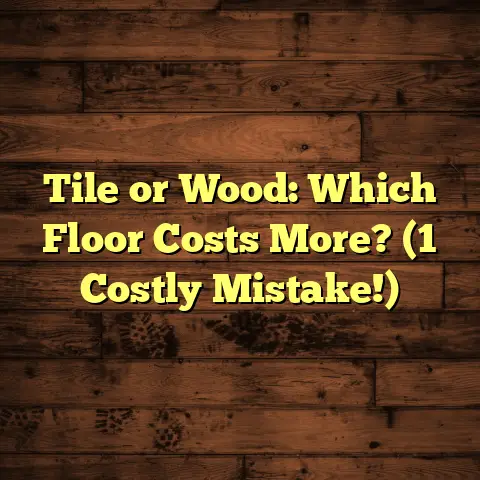How To Remove Existing Floor? (1-Day Demo Guide!)
Ever looked at your old, tired
flooring and thought, “It’s time
for a change!”?
I get it.
I’ve
been there countless times.
Flooring is super versatile,
right?
You’ve got hardwood,
laminate, tile, carpet – each
bringing its own vibe and
functionality to a space.
Choosing the right flooring is key to making your house a home, and sometimes, that means ripping out the old to make way for the new.
That’s where this guide comes in!
I’m going to walk you through how to remove your existing floor in just one day.
Yep, you read that right. A one-day demo! Let’s dive in!
Introduction: The Versatility
of Flooring
Think about it: flooring is the foundation of any room.
It sets the tone, influences the feel, and impacts the overall aesthetics.
From the warm, classic look of hardwood to the budget-friendly practicality of laminate, there’s a flooring option for every style and need.
I’ve seen it all, from water- damaged carpets to cracked and outdated tiles.
Sometimes, a simple change of flooring can completely transform a space.
But before you can enjoy your shiny new floors, you’s gotta get rid of the old ones.
That’s why I’m sharing my tried-and-true method for a quick and efficient floor removal.
This guide is designed to be accessible, even if you’re not a seasoned DIY pro.
With the right tools, a bit of planning, and a can-do attitude, you can tackle this project in a single day.
Section 1: Preparing for
the Floor Removal
Okay, let’s get down to brass tacks. Preparation is everything.
Trust me, you don’t want to be halfway through and realize you’re missing a crucial tool.
1. Gathering Necessary Tools
and Materials
Here’s your checklist:
- Pry Bar: Your best friend for lifting stubborn flooring.
- Hammer: For persuasion and driving the pry bar.
- Utility Knife: Essential for cutting carpet, vinyl, etc.
- Floor Scraper: To remove adhesive residue.
- Safety Goggles: Protect your eyes. Seriously, don’t skip this.
- Gloves: Save your hands from scratches and blisters.
- Knee Pads: Your knees will thank you.
- Adhesive Remover: For glued- down flooring.
- Trash Bags: Heavy-duty ones. You’ll need plenty.
- Dust Mask: Breathe easy.
I’ve learned the hard way that having the right tools makes all the difference.
It’s like trying to cook a gourmet meal with only a butter knife – frustrating and inefficient.
2. Assessing the Existing
Floor Type
Different flooring materials require different removal techniques.
- Tile: Requires breaking and chipping.
- Carpet: Involves cutting and detaching from tack strips.
- Laminate: Usually involves unlocking the click-lock system.
- Vinyl/Linoleum: Can be tricky if glued down.
- Hardwood: Nailed or glued, each with its own challenges.
Take a good look at your floor.
Is it tile, carpet, laminate, or
something else?
Knowing what you’re dealing with will help you choose the right approach and tools.
For example, removing ceramic tile will need a hammer and chisel.
While removing carpet requires a utility knife and pliers to pull out staples.
3. Planning the Project
Time to get organized!
- Create a Timeline: Break the removal process into manageable steps.
- Clear the Space: Remove all furniture, rugs, and other obstructions.
- Protect Surroundings: Cover nearby walls and doorways with plastic sheeting to contain dust.
I like to start early in the morning so that I can get the job done in one day.
A well-defined plan will help you stay on track and minimize stress.
Figure out how long each section should take and stick to the plan.
Section 2: Safety First
Alright, folks, before we start swinging hammers and pulling up flooring, let’s talk safety.
1. Personal Protective
Equipment (PPE)
This is non-negotiable.
- Safety Goggles: Protect your eyes from flying debris.
- Gloves: Protect your hands from cuts and scrapes.
- Dust Mask or Respirator: Protect your lungs from dust and allergens.
I’ve seen too many DIY projects go wrong because people skipped the safety gear.
Don’t be that person.
2. Preparing the Workspace
- Ventilation: Open windows and doors to ensure good airflow.
- Hazard Assessment: Check for any potential hazards, such as exposed wiring or asbestos (if dealing with older flooring).
- Containment: Use plastic sheeting to seal off the work area and prevent dust from spreading to other parts of your home.
Asbestos is a serious concern, especially in older homes.
If you suspect your flooring
contains asbestos, do not
attempt to remove it yourself.
Hire a qualified professional.
Section 3: Step-by-Step
Floor Removal Process
Okay, the moment you’ve been waiting for. Let’s get this floor out!
1. Carpet Removal
- Cut the Carpet: Use your utility knife to cut the carpet into manageable sections (e.g., 6×6 feet).
- Detach from Tack Strips: Use your pry bar or pliers to carefully detach the carpet from the tack strips along the edges of the room.
- Roll It Up: Roll up each section of carpet and secure it with tape or rope.
- Dispose: Dispose of the carpet according to your local waste disposal guidelines.
- Remove the Padding: Pull up
the carpet padding underneath.
This is usually stapled down.
Use pliers to pull out the staples.
I find that working in smaller sections makes the job much easier and less overwhelming.
2. Vinyl and Linoleum Removal
- Cut Through: Use your utility knife to cut through the vinyl or linoleum into strips.
- Lift Off: Start at one corner and use your pry bar or floor scraper to lift the flooring off the subfloor.
- Adhesive Removal: If the
flooring is glued down, use
your adhesive remover to soften
the glue.
Follow the product instructions carefully. - Scrape: Use your floor scraper to remove any remaining adhesive residue.
Sometimes, heating the vinyl or linoleum with a heat gun or hair dryer can help soften the adhesive and make it easier to remove.
Be careful not to overheat the flooring, as this can release harmful fumes.
3. Laminate Flooring Removal
- Locate the Starting Point: Usually, you can start at any edge of the room.
- Unlock the Planks: Use your pry bar or a specialized laminate removal tool to gently unlock the click-lock mechanism between the planks.
- Remove the Planks: Once unlocked, lift the planks and set them aside.
- Stack and Store (Optional): If you plan to reuse the laminate flooring, stack the planks neatly and store them in a dry place.
Laminate flooring is often the easiest type of flooring to remove, thanks to its click-lock system.
However, be careful not to damage the planks if you plan to reuse them.
4. Tile Removal
- Prepare: Cover the surrounding area with plastic sheeting to contain dust and debris.
- Break the Tiles: Use your hammer and chisel to break the tiles into smaller pieces.
- Remove the Pieces: Use your pry bar or floor scraper to remove the broken tile pieces from the subfloor.
- Mortar Removal: Use your chisel and hammer to remove any remaining mortar or adhesive residue.
- Clean the Subfloor: Use a stiff brush and vacuum to clean the subfloor.
Removing tile can be messy and time-consuming.
Patience is key.
Wear your safety goggles and dust mask.
5. Hardwood Floor Removal
- Identify the Fastening Method: Determine whether the hardwood boards are nailed or glued down.
- Nailed Hardwood: Use your
pry bar to lift the boards,
working along the seams.
Use a hammer to drive the pry bar if needed. - Glued Hardwood: Use your floor
scraper to lift the boards.
You may need to use adhesive remover to soften the glue. - Subfloor Inspection: Inspect the subfloor for any damage.
Be extra cautious when removing hardwood flooring to avoid damaging the subfloor underneath.
Damaging the subfloor can lead to costly repairs and delay your new flooring installation.
Section 4: Cleaning Up After
Floor Removal
Congratulations, you’ve successfully removed your old flooring!
But the job’s not done yet.
Cleaning up is just as important as the removal itself.
1. Disposing of Old Flooring
- Carpet: Check with your local
waste disposal guidelines for
proper disposal methods.
Some recycling centers may accept carpet. - Vinyl/Linoleum: Dispose of as general waste.
- Laminate: Can often be recycled. Check with your local recycling center.
- Tile: Dispose of as construction debris.
- Hardwood: Can sometimes be repurposed or recycled.
I always try to recycle or repurpose old flooring materials whenever possible.
It’s good for the environment and can save you money on disposal fees.
2. Cleaning the Subfloor
- Vacuum: Thoroughly vacuum the subfloor to remove dust, debris, and loose particles.
- Scrape: Use your floor scraper to remove any remaining adhesive, mortar, or other residue.
- Clean: Use a damp mop or
sponge to clean the subfloor.
Avoid using excessive water, as this can damage the subfloor. - Inspect: Inspect the subfloor for any damage, such as cracks, holes, or unevenness.
- Repair: Repair any damage to the subfloor before installing your new flooring.
A clean and level subfloor is essential for a successful new flooring installation.
Take the time to do it right.
Section 5: Final Thoughts
You did it! You’ve successfully removed your old flooring in just one day.
Give yourself a pat on the back.
Proper floor removal techniques are crucial for a smooth and successful new flooring installation.
By following this guide, you’ve saved yourself time, money, and stress.
Remember, with the right tools, preparation, and a can-do attitude, any DIY project is possible.
Now, go enjoy your newly transformed space!
Call to Action:
I’d love to hear about your experiences with floor removal projects.
Share your tips, tricks, and questions in the comments section below.
Let’s build a community of DIY enthusiasts and help each other create beautiful and functional homes.





